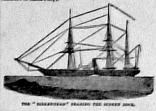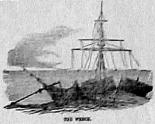

| MENU |

The HMS Birkenhead, also referred to as HM Troopship Birkenhead, was one of the first iron-hulled
ships built for the Royal Navy.
She was built in 1845 at John Laird's shipyard at Birkenhead as a frigate and named Vulcan, but the
Admiralty renamed her Birkenhead and had her converted into a troopship in 1848
In January 1852, under the command of Captain Robert Salmond, the Birkenhead left Portsmouth
conveying troops to the Cape Frontier War (then referred to as the Kaffir War) in South Africa. She
picked up more soldiers at Queenstown (now Cobh, Ireland), and was also conveying some officers'
wives and families.
In the late afternoon of 25 February 1852, the Birkenhead left Simon's Bay near Cape Town with
approximately 643 men, women, and children aboard, under instructions to reach its destination at
Algoa Bay as quickly as possible. In order to make the best speed possible, Captain Salmond decided to
hug the South African coast, setting a course which was usually no more than three miles from the
shore; using her paddle wheels she maintained a steady speed of 8.5 knots.
At 2 a.m. the following morning, the Birkenhead struck an uncharted rock near Danger Point (today near
Gansbaai, Western Cape). The impact was so violent that the forward compartment of the lower
troopdeck flooded instantly and over 100 soldiers were drowned in their hammocks. The surviving
officers and men assembled on deck, where Lt Col Seton of the 74th Foot took charge of all military
personnel and stressed the necessity of maintaining order and discipline to his officers. Distress rockets
were fired, but there was no assistance available. Sixty men were detailed to man the pumps, while the
rest were drawn up to await orders. Poor maintenance and paint on the winches resulted in only a few
of the ships' lifeboats being launched; eventually two cutters and a gig were launched, onto which all
the women and children were placed and rowed away for safety. Only then did Captain Salmond order
that those men who could swim should save themselves by swimming to the boats; Lt Col Seton,
however, recognising that rushing the lifeboats would risk swamping them and endangering the women
and children, ordered the men to stand fast. The soldiers did not move, even as the ship broke up barely
twenty minutes after striking the rock. Some of the soldiers managed to swim the 1.5–2 miles to shore
over the next twelve hours, often hanging on to pieces of the wreck to stay afloat; however, most either
drowned or were taken by sharks.
"I remained on the wreck until she went down; the suction took me down some way, and a man got hold of
my leg, but I managed to kick him off and came up and struck out for some pieces of wood that were on the
water and started for land, about two miles off. I was in the water about five hours, as the shore was so
rocky and the surf ran so high that a great many were lost trying to land. Nearly all those that took to the
water without their clothes on were taken by sharks; hundreds of them were all round us, and I saw men
taken by them close to me, but as I was dressed (having on a flannel shirt and trousers) they preferred the
others. I was not in the least hurt, and, am happy to say, kept my head clear; most of the officers lost their
lives from losing their presence of mind and trying to take money with them, and from not throwing off their
coats." - Letter from Lt J.F. Girardot, 43rd Light Infantry, to his father, 1 March 1852.[1]
The next morning the schooner Lioness discovered one of the cutters, and after saving the occupants of
the second boat made her way to the scene of the disaster. Arriving in the afternoon, she rescued as
many people as possible. It was reported that of the 643 people aboard the Birkenhead only 193 were
saved. The actual number of personnel aboard is in some doubt, but an estimate of 638 was published
in the Times newspaper. It is generally thought that the survivors comprised 113 Army personnel (all
ranks), 6 Royal Marines, 54 seamen (all ranks), 7 women and 13 children but these numbers cannot be
substantiated as muster rolls and books were lost with the ship.
This disaster was the origin of the phrase Women and Children First which became standard procedure
in maritime disasters, while the "Birkenhead Drill" carried out by the soldiers became the epitome of
courageous behaviour in hopeless circumstances. In fact, that phrase appears in Rudyard Kipling's
tribute to the royal marines, "Soldier an' Sailor Too":
To stand and be still
to the Birken’ead Drill
is a damn tough bullet to chew.
ships built for the Royal Navy.
She was built in 1845 at John Laird's shipyard at Birkenhead as a frigate and named Vulcan, but the
Admiralty renamed her Birkenhead and had her converted into a troopship in 1848
In January 1852, under the command of Captain Robert Salmond, the Birkenhead left Portsmouth
conveying troops to the Cape Frontier War (then referred to as the Kaffir War) in South Africa. She
picked up more soldiers at Queenstown (now Cobh, Ireland), and was also conveying some officers'
wives and families.
In the late afternoon of 25 February 1852, the Birkenhead left Simon's Bay near Cape Town with
approximately 643 men, women, and children aboard, under instructions to reach its destination at
Algoa Bay as quickly as possible. In order to make the best speed possible, Captain Salmond decided to
hug the South African coast, setting a course which was usually no more than three miles from the
shore; using her paddle wheels she maintained a steady speed of 8.5 knots.
At 2 a.m. the following morning, the Birkenhead struck an uncharted rock near Danger Point (today near
Gansbaai, Western Cape). The impact was so violent that the forward compartment of the lower
troopdeck flooded instantly and over 100 soldiers were drowned in their hammocks. The surviving
officers and men assembled on deck, where Lt Col Seton of the 74th Foot took charge of all military
personnel and stressed the necessity of maintaining order and discipline to his officers. Distress rockets
were fired, but there was no assistance available. Sixty men were detailed to man the pumps, while the
rest were drawn up to await orders. Poor maintenance and paint on the winches resulted in only a few
of the ships' lifeboats being launched; eventually two cutters and a gig were launched, onto which all
the women and children were placed and rowed away for safety. Only then did Captain Salmond order
that those men who could swim should save themselves by swimming to the boats; Lt Col Seton,
however, recognising that rushing the lifeboats would risk swamping them and endangering the women
and children, ordered the men to stand fast. The soldiers did not move, even as the ship broke up barely
twenty minutes after striking the rock. Some of the soldiers managed to swim the 1.5–2 miles to shore
over the next twelve hours, often hanging on to pieces of the wreck to stay afloat; however, most either
drowned or were taken by sharks.
"I remained on the wreck until she went down; the suction took me down some way, and a man got hold of
my leg, but I managed to kick him off and came up and struck out for some pieces of wood that were on the
water and started for land, about two miles off. I was in the water about five hours, as the shore was so
rocky and the surf ran so high that a great many were lost trying to land. Nearly all those that took to the
water without their clothes on were taken by sharks; hundreds of them were all round us, and I saw men
taken by them close to me, but as I was dressed (having on a flannel shirt and trousers) they preferred the
others. I was not in the least hurt, and, am happy to say, kept my head clear; most of the officers lost their
lives from losing their presence of mind and trying to take money with them, and from not throwing off their
coats." - Letter from Lt J.F. Girardot, 43rd Light Infantry, to his father, 1 March 1852.[1]
The next morning the schooner Lioness discovered one of the cutters, and after saving the occupants of
the second boat made her way to the scene of the disaster. Arriving in the afternoon, she rescued as
many people as possible. It was reported that of the 643 people aboard the Birkenhead only 193 were
saved. The actual number of personnel aboard is in some doubt, but an estimate of 638 was published
in the Times newspaper. It is generally thought that the survivors comprised 113 Army personnel (all
ranks), 6 Royal Marines, 54 seamen (all ranks), 7 women and 13 children but these numbers cannot be
substantiated as muster rolls and books were lost with the ship.
This disaster was the origin of the phrase Women and Children First which became standard procedure
in maritime disasters, while the "Birkenhead Drill" carried out by the soldiers became the epitome of
courageous behaviour in hopeless circumstances. In fact, that phrase appears in Rudyard Kipling's
tribute to the royal marines, "Soldier an' Sailor Too":
To stand and be still
to the Birken’ead Drill
is a damn tough bullet to chew.






| Below is a witnesses sketch drawn of HMS Birkenhead showing how she broke up before sinking. |